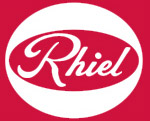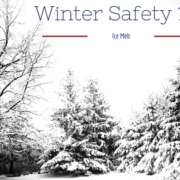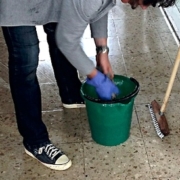Winter Safety 101: Are You Using The Right Ice Melt?
Volumes have been written on the scientific data produced to explain how Ice Melters work and which products are best to use. There are seemingly hundreds of products on the market today. I will try to simplify this process of how to select and apply the correct ice melting product for your application. Ice melters come in dry, granulated form or in liquid. Liquids are used to chemically treat granulated product or are applied directly to the surface to prevent ice buildup before it starts to snow. Dry, granulated ice melters are applied after the snow and are used to remove the buildup rather than prevent it. Dry, granulated product is much more common so let’s concentrate on how these work for now.
The way Dry Ice melting products work is really pretty basic. They melt the surface area of the ice where granulated product has been applied. It melts through the ice and creates a brine mixture with the melted water. This brine works its way under the surrounding ice and loosens the bond between the ice and the ground. The ice then continues to melt or is lifted away by mechanical removal, either with a blade or a snow shovel.
There are 4 main types of dry deicing products used on the market today. Sodium Chloride, Magnesium Chloride, Calcium Chloride and Potassium Chloride.
Acetate based products could be classified as a 5th category but they are expensive. They are used as a specialty product for areas where chloride based products may damage steel structures by rust and corrosion. Primarily they are used in parking decks, bridges and airports. The chloride based products are the most common and what most people are used to using.
Sodium Chloride: Rock Salt is the most common of all products used to melt ice. It works effectively down to +18F Degrees but seems to work best in the +20F to +25F degree range. It is readily available and comes from a variety of sources. It is cheap and easy to use. Consider however the damage this product can produce. Over application of Sodium and Chloride can create runoff that can kill vegetation and kill all the fish in your fish pond. So it is best reserved for parking lots and main thoroughfares.
Magnesium Chloride: More expensive than rock salt but it is traditionally easier on the environment. It doesn’t track as much as other products, has lower toxicity, and works at lower temperatures than salt. Magnesium Chloride will melt ice effectively down to -10 to -13 degrees.
Calcium Chloride: This is naturally occurring just like Sodium and Magnesium Chloride and relatively easy to acquire. It is more expensive than Sodium or Magnesium Chloride because of the processing it requires to dry and bag. It is a premium product and will effectively melt ice down to -25 degrees. It works quickly. It’s easy to use more than you need. Because of how fast it works at such low temperatures it can be easily over applied. Over application can lead to tracking which can cause damage to entryways and carpet. At the right application rate, at low temperatures, for the money, nothing works better or faster than Calcium Chloride.
Potassium Chloride: Potassium is one of the principal ingredients in fertilizer. It was once more widely used as an ice melter because of its low environmental impact. It works effectively down to +25 degrees. In recent years the price of fertilizer has driven up the cost of Potassium Chloride to make it cost prohibitive to use as an ice melter.
Sodium Chloride or rock salt is the most common product used to melt ice. But the trend today is to blend the above products and lower the effective melting temperature without raising the price too high. It is common to find sodium chloride based products which are 80% to 95% salt blended with Magnesium, Calcium and Potassium. Manufacturers may also add surfactants to help the melted brine spread more effectively and quickly. Anti-clogging agents are added to reduce clogging in spreaders. Marking agents are used to color the ice melter so it becomes more visible where it has been spread. They don’t affect the melting ability but make it easier to see where it is applied.
To determine which ice meting product is best suited for your facility please contact us. We can provide the answers you need to reduce slip and fall accidents and help clear you parking lots, walkways and other snow & ice covered areas.



